Setting Times of Early-Age Mortars Determined from Evolution Curves of Poisson’s Ratio
Abstract
:1. Introduction
2. Materials and Experimental Methods
2.1. Materials
2.2. Ultrasonic Pulse Velocity Test
3. Results
3.1. Vp Evolution Curves
3.2. Fitting Methods and Parameters
3.3. Ed, G, K, and ν Evolution Curves
4. Discussion
4.1. Setting Times Determined from Derivatives of Poisson’s Ratio Evolution Curves
4.2. Comparison with Derivative Methods on Vs, Ed, Vp, K and G Evolution Curves
5. Conclusions
- (1)
- The signature times of the derivatives of the Poisson’s ratio evolution curves were found to correlate well with the initial and final setting times, with R2 values of 0.865 and 0.950–0.962, respectively, based on the data reported by Carrette and Staquet (2015, 2016) and by this study. The derivative method on the Poisson’s ratio evolution curve is as good as the derivative methods from shear wave velocity evolution curves used by Naji et al. (2017, 2018) and Zhu et al. (2018). The two methods are recommended for estimation of both the initial and final setting times of the early-age properties of cement-based materials.
- (2)
- The signature times of the inflection points of the Ed evolution curves correlated well with the final setting times measured by standard penetration tests, with R2 values of 0.966 (data in this study) and 0.886 (data in Carette and Staquet, 2015), respectively. Therefore, the derivative method on the Ed evolution curve is validated by this study, and is recommended for the estimation of the final setting time of the early-age properties of cement-based materials.
- (3)
- During the early hydration stage, the C3A and gypsum were consumed and ettringite of comparatively lower Poisson’s ratio (0.25) was formed. This is postulated to cause the initial dip in the Poisson’s ratio evolution curves of all six mortar specimens tested in this study. After the final setting, excessive C3A reacted with ettringite, and monosulfoaluminate of higher Poisson’s ratio (than ettringite) was generated. Monosulfoaluminate generation, together with the pore filling/densifying effect caused by the hydration of calcium silicate phases, was postulated to cause further increment in the Poisson’s ratio.
- (4)
- The preliminary results of this study suggested that the Poisson’s ratio derivative method could predict setting times of cementitious materials, especially the final setting times, reasonably well. But this method is suggested for use under the specific conditions of this study, i.e., the same testing setup, the same testing environment, the same cement and aggregate. Further measurements of other cementitious materials, including a variety of water-cement ratios and mortar with different binders, are necessary for the assessment of the reliability of the proposed method in the future.
Author Contributions
Funding
Acknowledgments
Conflicts of Interest
References
- Wang, D.; Yu, G.; Liu, S.; Sheng, P. Monitoring the Setting Process of Cementitious Materials Using Guided Waves in Thin Rods. Materials 2021, 14, 566. [Google Scholar] [CrossRef] [PubMed]
- Ghorbani, S.; Gholizadeh, M.; De Brito, J. Effect of Magnetized Water on the Mechanical and Durability Properties of Concrete Block Pavers. Materials 2018, 11, 1647. [Google Scholar] [CrossRef] [Green Version]
- Javier Vazquez-Rodriguez, F.; Ellizondo-Villareal, N.; Hypatia Verastegui, L.; Arato Tovar, A.M.; Fernando Lopez-Perales, J.; de Leon, J.E.; Gomez-Rodriguez, C.; Fernandez-Gonzalez, D.; Felipe Verdeja, L.; Viviana Garcia-Quinonez, L.; et al. Effect of mineral aggregates and chemical admixtures as internal curing agents on the me-chanical properties and durability of high-performance concrete. Materials 2020, 13, 2090. [Google Scholar] [CrossRef] [PubMed]
- Kim, S.S.; Qudoos, A.; Jakhrani, S.H.; Lee, J.B.; Kim, H.G. Influence of Coarse Aggregates and Silica Fume on the Mechanical Properties, Durability, and Microstructure of Concrete. Materials 2019, 12, 3324. [Google Scholar] [CrossRef] [PubMed] [Green Version]
- Gu, X.; Li, X.; Zhang, W.; Gao, Y.; Kong, Y.; Liu, J.; Zhang, X. Effects of HPMC on Workability and Mechanical Properties of Concrete Using Iron Tailings as Aggregates. Materials 2021, 14, 6451. [Google Scholar] [CrossRef] [PubMed]
- Bolborea, B.; Baera, C.; Dan, S.; Gruin, A.; Burduhos-Nergis, D.-D.; Vasile, V. Concrete Compressive Strength by Means of Ultrasonic Pulse Velocity and Moduli of Elasticity. Materials 2021, 14, 7018. [Google Scholar] [CrossRef] [PubMed]
- Monaco, M.; Aurilio, M.; Tafuro, A.; Guadagnuolo, M. Sustainable mortars for application in the cultural heritage field. Materials 2021, 14, 598. [Google Scholar] [CrossRef] [PubMed]
- Ryu, G.-S.; Choi, S.; Koh, K.-T.; Ahn, G.-H.; Kim, H.-Y.; You, Y.-J. A Study on Initial Setting and Modulus of Elasticity of AAM Mortar Mixed with CSA Expansive Additive Using Ultrasonic Pulse Velocity. Materials 2020, 13, 4432. [Google Scholar] [CrossRef] [PubMed]
- ASTM C403/C403M-16. Standard Test Method for Time of Setting of Concrete Mixtures by Penetration Resistance; ASTM International: West Conshohocken, PA, USA, 2016. [Google Scholar]
- ASTM C191-21. Standard Test Methods for Time of Setting of Hydraulic Cement by Vicat Needle; ASTM International: West Conshohocken, PA, USA, 2021. [Google Scholar]
- Sandberg, J.P.; Liberman, S. Monitoring and evaluation of cement hydration by semi-adiabatic field calorimetry. Spec. Publ. 2007, 241, 13–24. [Google Scholar]
- Zhang, J.; Fan, T.; Ma, H.; Li, Z. Monitoring setting and hardening of concrete by active acoustic method: Effects of water-to-cement ratio and pozzolanic materials. Constr. Build. Mater. 2015, 88, 118–125. [Google Scholar] [CrossRef]
- Trtnik, G.; Turk, G.; Kavčič, F.; Bosiljkov, V.B. Possibilities of using the ultrasonic wave transmission method to estimate initial setting time of cement paste. Cem. Concr. Res. 2008, 38, 1336–1342. [Google Scholar] [CrossRef] [Green Version]
- Zhang, J.; Qin, L.; Li, Z. Hydration monitoring of cement-based materials with resistivity and ultrasonic methods. Mater. Struct. 2008, 42, 15–24. [Google Scholar] [CrossRef]
- Lu, Y.; Zhang, J.; Li, Z. Study on hydration process of early-age concrete using embedded active acoustic and non-contact complex resistivity methods. Constr. Build. Mater. 2013, 46, 183–192. [Google Scholar] [CrossRef]
- Qin, L.; Li, Z. Monitoring of cement hydration using embedded piezoelectric transducers. Smart Mater. Struct. 2008, 17, 055005. [Google Scholar] [CrossRef]
- Smith, A.; Chotard, T.; Gimet-Breart, N.; Fargeot, D. Correlation between hydration mechanism and ultrasonic measurements in an aluminous cement: Effect of setting time and temperature on the early hydration. J. Eur. Ceram. Soc. 2002, 22, 1947–1958. [Google Scholar] [CrossRef]
- Ozturk, T.; Rapoport, J.; Popovics, J.S.; Shah, S.P. Monitoring the setting and hardening of cement-based materials with ultrasound. Concr. Sci. Eng. 1999, 1, 83–91. [Google Scholar]
- Voigt, T.; Grosse, C.U.; Sun, Z.; Shah, S.P.; Reinhardt, H.-W. Comparison of ultrasonic wave transmission and reflection measurements with P- and S-waves on early age mortar and concrete. Mater. Struct. 2005, 38, 729–738. [Google Scholar] [CrossRef]
- Voigt, T.; Sun, Z.; Shah, S.P. Comparison of ultrasonic wave reflection method and maturity method in evaluating early-age compressive strength of mortar. Cem. Concr. Compos. 2006, 28, 307–316. [Google Scholar] [CrossRef]
- Sun, Z. Monitoring the Early-Age Properties of Cementitious Materials with Ultrasonic Wave Reflection Method at Mac-ro-and Micro-Structural Levels. Ph.D. Thesis, Northwestern University, Evanston, IL, USA, 2005. [Google Scholar]
- Naji, S.; Karray, M.; Khayat, K.H. Versatility of Piezoelectric Ring Actuator Technique (P-RAT) for Characteriza-tion of Cement Paste and Mortar. Advances in Civil Engineering Materials 2017, 6, 189–212. [Google Scholar] [CrossRef]
- Naji, S.; Khayat, K.; Karray, M. Effect of Piezoelectric Ring Sensor Size on Early-Age Property Monitoring of Self-Consolidating Concrete. ACI Mater. J. 2018, 115. [Google Scholar] [CrossRef]
- Reinhardt, H.-W.; Grosse, C.; Herb, A.; Weiler, B.; Schmidt, G. Method for Examining a Solidifying and/or Hardening Material Using Ultrasound, Receptacle and Ultrasound Sensor for Carrying out the Method. U.S. Patent 6,655,213, 2 December 2003. [Google Scholar]
- Reinhardt, H.; Grosse, C. Continuous monitoring of setting and hardening of mortar and concrete. Constr. Build. Mater. 2004, 18, 145–154. [Google Scholar] [CrossRef]
- Lee, H.; Lee, K.; Kim, Y.; Yim, H.; Bae, D. Ultrasonic in-situ monitoring of setting process of high-performance concrete. Cem. Concr. Res. 2004, 34, 631–640. [Google Scholar] [CrossRef]
- Carette, J.; Staquet, S. Monitoring the setting process of mortars by ultrasonic P and S-wave transmission velocity measurement. Constr. Build. Mater. 2015, 94, 196–208. [Google Scholar] [CrossRef]
- Carette, J.; Staquet, S. Monitoring the setting process of eco-binders by ultrasonic P-wave and S-wave transmission velocity measurement: Mortar vs concrete. Constr. Build. Mater. 2016, 110, 32–41. [Google Scholar] [CrossRef]
- Liu, S.; Zhu, J.; Seraj, S.; Cano, R.; Juenger, M. Monitoring setting and hardening process of mortar and concrete using ultrasonic shear waves. Constr. Build. Mater. 2014, 72, 248–255. [Google Scholar] [CrossRef]
- Zhu, J.; Cao, J.N.; Bate, B.; Khayat, K.H. Determination of mortar setting times using shear wave velocity evolu-tion curves measured by the bender element technique. Cem. Concr. Res. 2018, 106, 1–11. [Google Scholar] [CrossRef]
- Bate, B.; Khayat, K.H.; Zhang, S.; Chen, P. Reply to “A discussion on the paper ‘Determination of mortar setting times using shear wave velocity evolution curves measured by the bender element technique’” by J. Carette and S. Staquet. Cem. Concr. Res. 2019, 115, 203–206. [Google Scholar] [CrossRef]
- Boumiz, A.; Vernet, C.; Tenoudji, F.C. Mechanical properties of cement pastes and mortars at early ages: Evolution with time and degree of hydration. Adv. Cem. Based Mater. 1996, 3, 94–106. [Google Scholar] [CrossRef]
- Silva, J.; Azenha, M.; Correia, A.G.; Ferreira, C. Continuous stiffness assessment of cement-stabilised soils from early age. Géotechnique 2013, 63, 1419–1432. [Google Scholar] [CrossRef]
- Ghoddousi, P.; Javid, A.A.S.; Sobhani, J.; Alamdari, A.Z. A new method to determine initial setting time of cement and concrete using plate test. Mater. Struct. 2015, 49, 3135–3142. [Google Scholar] [CrossRef]
- Bate, B.; Choo, H.; Burns, S. Dynamic properties of fine-grained soils engineered with a controlled organic phase. Soil Dyn. Earthq. Eng. 2013, 53, 176–186. [Google Scholar] [CrossRef]
- Kang, X.; Kang, G.C.; Bate, B. Shear wave velocity anisotropy of kaolinite using a floating wall consolidome-ter-type bender element testing system. Geotech. Test. J. 2014, 37, 869–883. [Google Scholar] [CrossRef]
- ASTM C150/C150M-21. Standard Specification for Portland Cement; ASTM International: West Conshohocken, PA, USA, 2021. [Google Scholar]
- ASTM C494/C494M-17. Standard Specification for Chemical Admixtures for Concrete; ASTM International: West Con-shohocken, PA, USA, 2017. [Google Scholar]
- ASTM C305-20. Standard Practice for Mechanical Mixing of Hydraulic Cement Pastes and Mortars of Plastic Consistency; ASTM International: West Conshohocken, PA, USA, 2020. [Google Scholar]
- ASTM C597. Standard Test Method for Pulse Velocity through Concrete; ASTM International: West Conshohocken, PA, USA, 2016. [Google Scholar]
- Wang, P. Identification of Initial and Final Setting Time of Cement Paste by Electrical and Ultrasonic Methods. Master Thesis, Tsinghua University, Beijing, China, 1 May 2014. [Google Scholar]
- Fredlund, D.; Xing, A. Equations for the soil-water characteristic curve. Can. Geotech. J. 1994, 31, 521–532. [Google Scholar] [CrossRef]
- Swamy, N.; Rigby, G. Dynamic properties of hardened paste, mortar and concrete. Mater. Struct. 1971, 4, 13–40. [Google Scholar] [CrossRef]
- Vipulanandan, C.; Garas, V. Electrical resistivity, pulse velocity, and compressive properties of carbon fi-ber-reinforced cement mortar. J. Mater. Civ. Eng. 2008, 20, 93–101. [Google Scholar] [CrossRef]
- Bosiljkov, V.Z.; Totoev, Y.Z.; Nichols, J.M. Shear modulus and stiffness of brickwork masonry: An experimental perspective. Struct. Eng. Mech. 2005, 20, 21–43. [Google Scholar] [CrossRef] [Green Version]
- Oh, T.K. Defect Characterization in Concrete Elements Using Vibration Analysis and Imaging. Ph.D. Thesis, University of Illinois at Urbana-Champaign, Champaign, IL, USA, 2012. [Google Scholar]
- Mehta, P.K. Concrete. Structure, Properties and Materials. Prentice-Hall: Englewood Cliffs, NJ, USA, 1986. [Google Scholar]
- Li, X.; Grasley, Z.C.; Bullard, J.W.; Garboczi, E.J. Computing the time evolution of the apparent viscoelas-tic/viscoplastic Poisson’s ratio of hydrating cement paste. Cem. Concr. Compos. 2015, 56, 121–133. [Google Scholar] [CrossRef]
- Laugesen, J. Density functional calculations of elastic properties of portlandite, Ca(OH)2. Cem. Concr. Res. 2005, 35, 199–202. [Google Scholar] [CrossRef]
- Pellenq, R.J.-M.; Kushima, A.; Shahsavari, R.; Van Vliet, K.J.; Buehler, M.; Yip, S.; Ulm, F.-J. A realistic molecular model of cement hydrates. Proc. Natl. Acad. Sci. USA 2009, 106, 16102–16107. [Google Scholar] [CrossRef] [PubMed] [Green Version]
- Termkhajornkit, P.; Vu, Q.H.; Barbarulo, R.; Daronnat, S.; Chanvillard, G. Dependence of compressive strength on phase assemblage in cement pastes: Beyond gel–space ratio—Experimental evidence and micromechanical modeling. Cem. Concr. Res. 2014, 56, 1–11. [Google Scholar] [CrossRef]
- Velez, K.; Maximilien, S.; Damidot, D.; Fantozzi, G.; Sorrentino, F. Determination by nanoindentation of elastic modulus and hardness of pure constituents of Portland cement clinker. Cem. Concr. Res. 2001, 31, 555–561. [Google Scholar] [CrossRef]
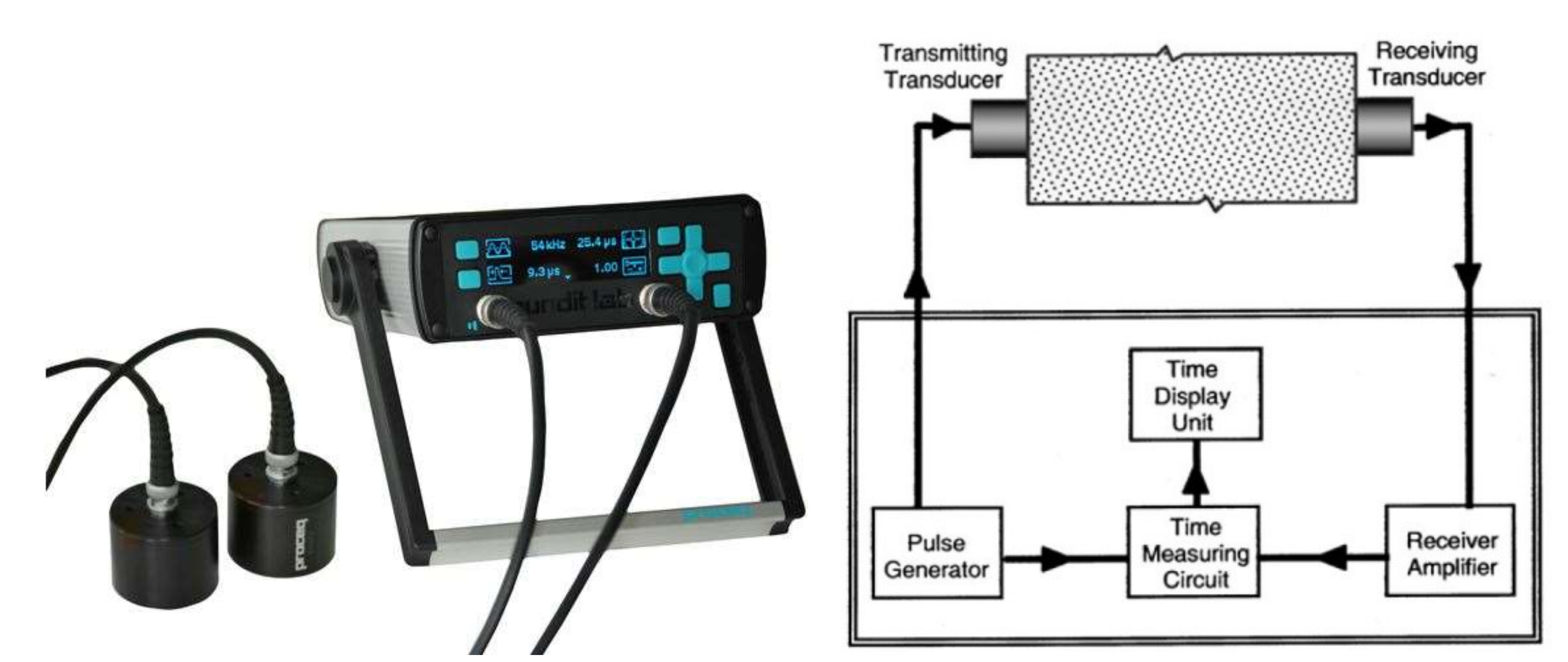

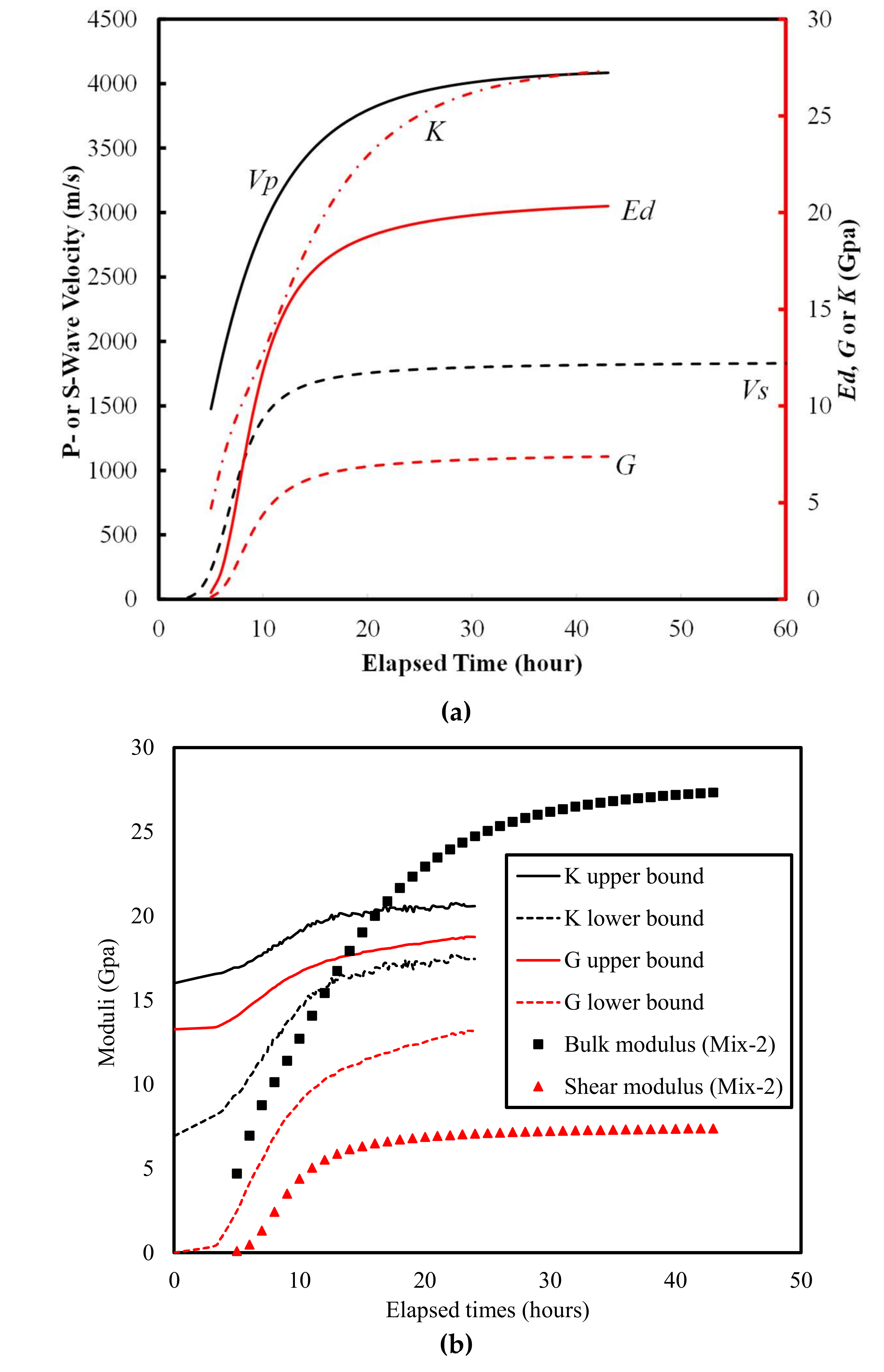
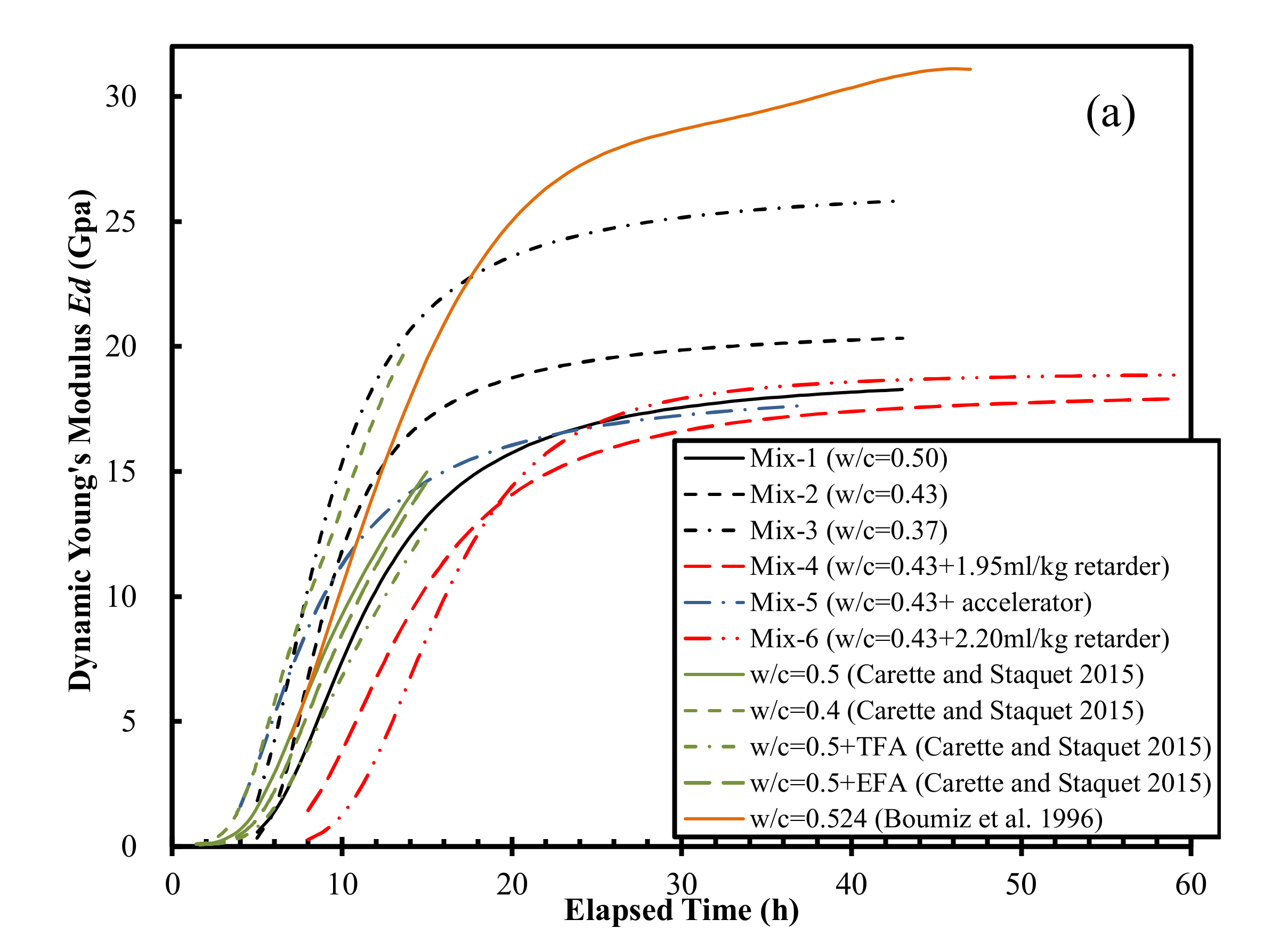

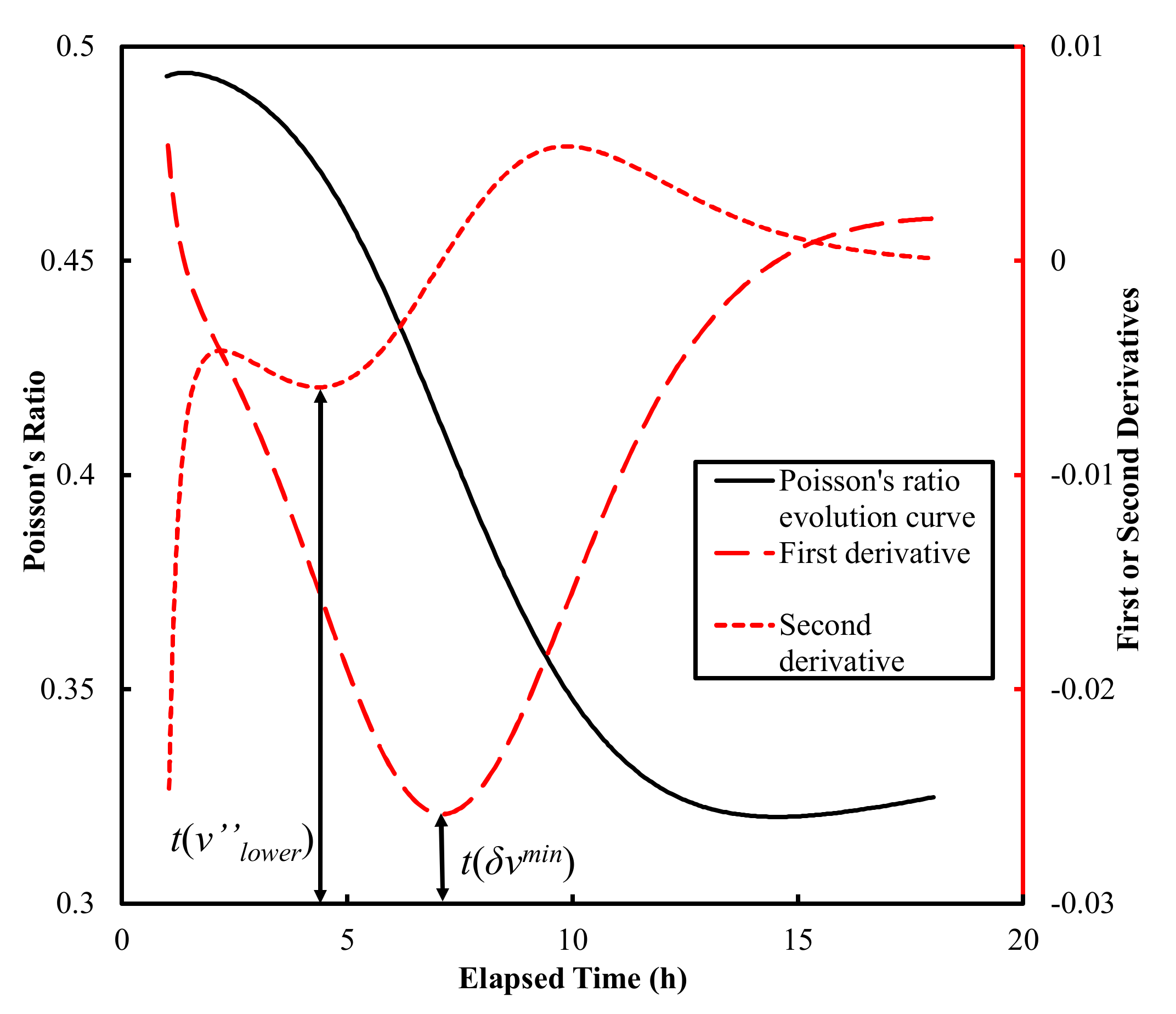

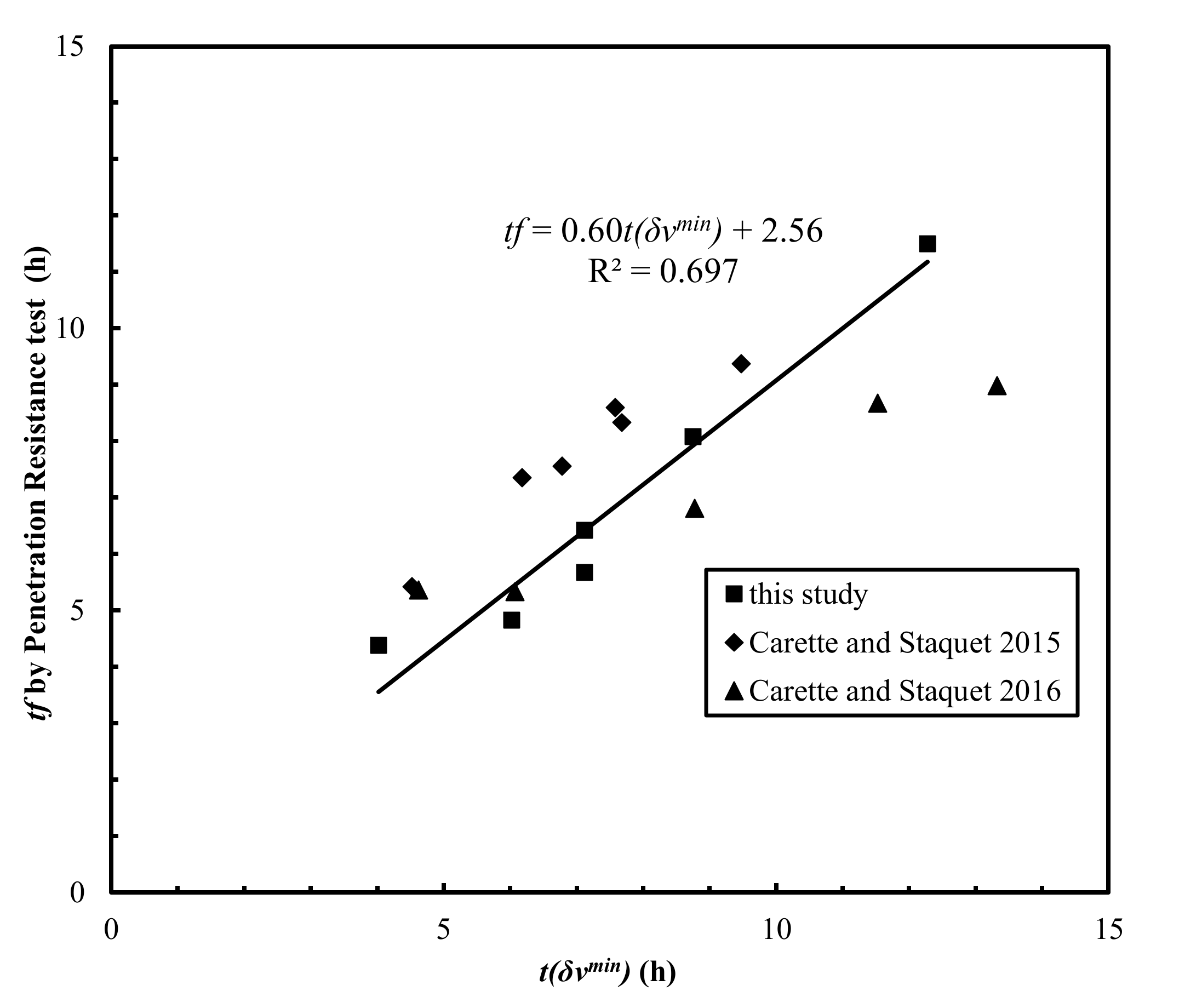
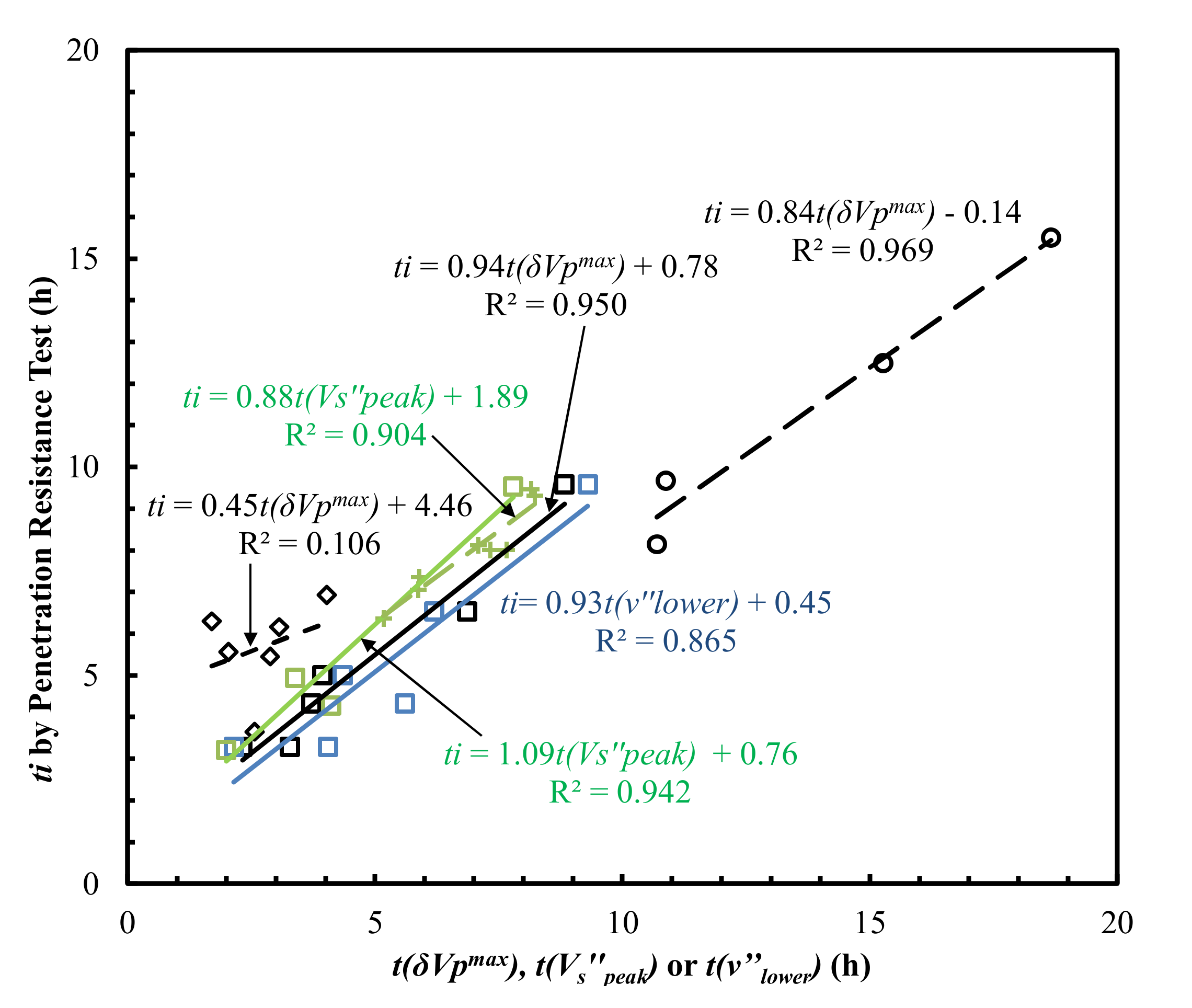
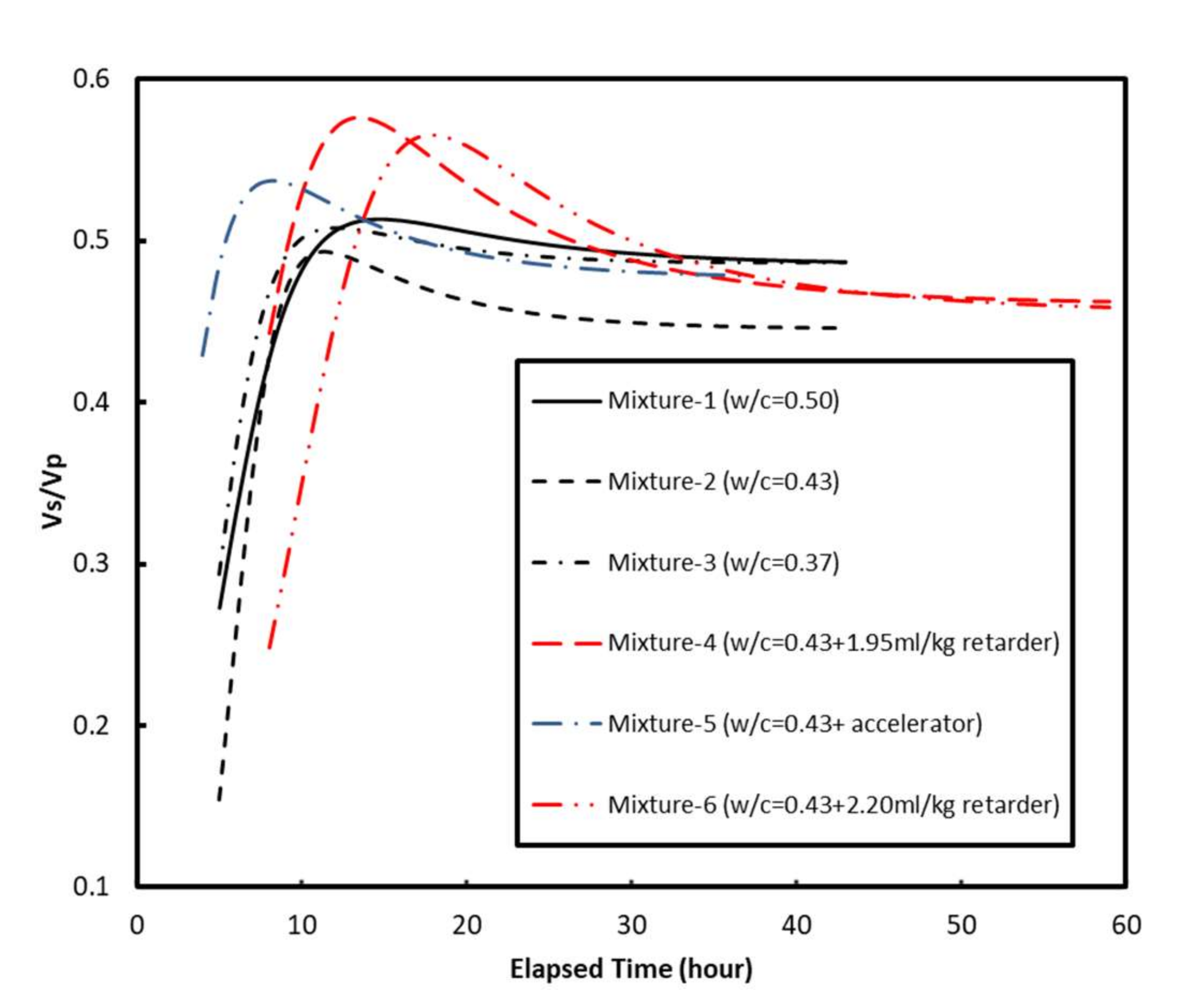

| Method | Time Evolution of | 1st Derivative | 2nd Derivative | ti | tf | References | Note * |
|---|---|---|---|---|---|---|---|
| Ultrasonic pulse velocity | Vp | Y | - | Y | - | [11,12,13,14,15,16,17] | Degree of agreement with Vicat needle method varies. |
| Ultrasonic wave reflection | Vs | Y | - | Y | Y | [18,19,20,21] | R2 = 0.82 |
| Piezoceramic ring | Vs | Y | - | Y | Y | [22,23] | R2 = 0.89 |
| FreshCon system | Vs & Vp | Y | - | Y | Y | [24,25,26,27,28] | R2 = 0.106–0.969 (ti), R2 = 0.158–0.959 (tf) |
| Piezoceramic plate (bender element) | Vs | Y | Y | Y | Y | [29,30,31,32] | R2 = 0.742–0.950 (ti), R2 = 0.861–0.979 (tf) |
| Elasticity modulus (Ed) | Ed | Y | - | - | Y | [27,28,33] | R2 = 0.886–0.966 (tf) |
| Electrical resistivity | electrical resistivity | Y | - | Y | Y | [14,15] | R2 = 0.895 (ti), 0.989 (tf) |
| Poisson’s ratio (ν) | ν | Y | Y | Y | Y | This study |
| Mix Design | Mixture-1 | Mixture-2 | Mixture-3 | Mixture-4 | Mixture-5 | Mixture-6 |
|---|---|---|---|---|---|---|
| w/c | 0.5 | 0.43 | 0.37 | 0.43 | 0.43 | 0.43 |
| Cement (kg/m3) | 673 | 713 | 751 | 713 | 713 | 713 |
| Sand (kg/m3) | 1137 | 1203 | 1267 | 1203 | 1203 | 1203 |
| Water (kg/m3) | 337 | 313 | 277 | 313 | 313 | 313 |
| Unit weight (kg/m3) | 2177.5 | 2273.5 | 2309.2 | 2253.0 | 2222.4 | 2253.0 |
| Retarder (mL/100 kg of cement) | -- | -- | -- | 195 | -- | 220 |
| Accelerator (mL/100 kg of cement) | -- | -- | -- | -- | 1500 | -- |
| t(δVpmax) (h) | 3.94 | 3.71 | 3.28 | 6.86 | 2.32 | 8.83 |
| t(ν’’lower) (h) | 4.35 | 5.6 | 4.05 | 6.2 | 2.15 | 9.30 |
| t(Vs’’peak) (h)* | 4.59 | 5.32 | 3.03 | 6.78 | 3.13 | 9.17 |
| ti (h) | 5 | 4.33 | 3.28 | 6.53 | 3.28 | 9.58 |
| t(δVpmax) (h) | 3.94 | 3.71 | 3.28 | 6.86 | 2.32 | 8.83 |
| t(δEdmax) (h) | 8.93 | 8.42 | 7.31 | 11.14 | 5.87 | 13.74 |
| t(δνmin) (h) | 7.12 | 7.12 | 6.02 | 8.75 | 4.02 | 12.28 |
| t(Vs’peak) (h)* | 6.50 | 6.20 | 5.10 | 8.50 | 3.80 | 11.50 |
| tf (h) | 6.42 | 5.67 | 4.83 | 8.08 | 4.38 | 11.50 |
| Type of Evolution Curves | Fitting Equation | Parameters | Mixture-1 | Mixture-2 | Mixture-3 | Mixture-4 | Mixture-5 | Mixture-6 |
|---|---|---|---|---|---|---|---|---|
| Vp evolution curves | Lognormal | Μ | 2.04 | 1.88 | 1.75 | 2.49 | 1.85 | 2.59 |
| Σ | 0.82 | 0.76 | 0.75 | 0.75 | 1.00 | 0.64 | ||
| vp,max | 3738.4 | 4071.7 | 4137.5 | 3806.8 | 3762.8 | 3809.5 | ||
| C | 0.00 | 0.00 | 0.00 | 0.00 | 0.00 | 0.00 | ||
| R2 | 0.992 | 0.996 | 0.994 | 0.997 | 0.996 | 0.997 | ||
| Ed evolution curves | Lognormal | μ | 2.38 | 2.25 | 2.17 | 2.55 | 2.07 | 2.70 |
| σ | 0.43 | 0.35 | 0.42 | 0.37 | 0.55 | 0.29 | ||
| Ed,max | 16.99 | 19.27 | 24.18 | 15.39 | 16.89 | 16.68 | ||
| c | 0.00 | 0.00 | 0.00 | 0.00 | 0.00 | 0.00 | ||
| R2 | 0.999 | 0.999 | 0.999 | 0.999 | 0.999 | 0.999 | ||
| Vs evolution curves * | Modified Fredlund and Xing | a | 8.07 | 6.70 | 6.19 | 9.78 | 4.82 | 14.35 |
| n | 3.01 | 5.20 | 3.46 | 3.68 | 2.68 | 4.05 | ||
| m | 2.26 | 1.66 | 1.92 | 2.16 | 1.82 | 3.71 | ||
| R2 | 0.999 | 0.995 | 0.999 | 0.997 | 0.998 | 0.999 |
Publisher’s Note: MDPI stays neutral with regard to jurisdictional claims in published maps and institutional affiliations. |
© 2022 by the authors. Licensee MDPI, Basel, Switzerland. This article is an open access article distributed under the terms and conditions of the Creative Commons Attribution (CC BY) license (https://creativecommons.org/licenses/by/4.0/).
Share and Cite
Bate, B.; Chen, X.; Chen, C.; Ma, H.; Zhu, J.; Cao, J.; Chen, J.; Khayat, K.H.; Zhang, S. Setting Times of Early-Age Mortars Determined from Evolution Curves of Poisson’s Ratio. Materials 2022, 15, 853. https://doi.org/10.3390/ma15030853
Bate B, Chen X, Chen C, Ma H, Zhu J, Cao J, Chen J, Khayat KH, Zhang S. Setting Times of Early-Age Mortars Determined from Evolution Curves of Poisson’s Ratio. Materials. 2022; 15(3):853. https://doi.org/10.3390/ma15030853
Chicago/Turabian StyleBate, Bate, Xiao Chen, Chao Chen, Hongyan Ma, Jianfeng Zhu, Junnan Cao, Jiakai Chen, Kamal H. Khayat, and Shuai Zhang. 2022. "Setting Times of Early-Age Mortars Determined from Evolution Curves of Poisson’s Ratio" Materials 15, no. 3: 853. https://doi.org/10.3390/ma15030853
APA StyleBate, B., Chen, X., Chen, C., Ma, H., Zhu, J., Cao, J., Chen, J., Khayat, K. H., & Zhang, S. (2022). Setting Times of Early-Age Mortars Determined from Evolution Curves of Poisson’s Ratio. Materials, 15(3), 853. https://doi.org/10.3390/ma15030853








